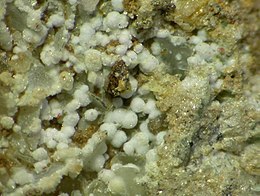Brianyoungite is a secondary zinc carbonate mineral. The Commission on New Minerals, Nomenclature and Classification (CNMNC) of the International Mineralogical Association (IMA) classifies it as a carbonate with the formula Zn3(CO3)(OH)4,[1] but sulfate groups SO4 also occupy the carbonate CO3 positions, in the ratio of about one sulfate to three carbonates,[3] so other sources give the formula as Zn3(CO3,SO4)(OH)4, and Gaines et al. classify the mineral as a compound carbonate.[7] It is similar in appearance to hydrozincite, another zinc carbonate.[5] It was discovered in 1991 and designated IMA1991-053.[5] In 1993 it was named "brianyoungite" after Brian Young (born 1947), a field geologist with the British Geological Survey, who provided the first specimens.[4][7]
| Brianyoungite | |
|---|---|
 Brianyoungite from Germany | |
| General | |
| Category | Carbonate mineral |
| Formula (repeating unit) | Zn3(CO3,SO4)(OH)4[1] |
| IMA symbol | Byo[2] |
| Strunz classification | 5.BF.30 (10 ed) 5/C.01-105 (8 ed) |
| Dana classification | 17.1.15 |
| Crystal system | Monoclinic |
| Crystal class | Prismatic (2/m) (same H-M symbol) |
| Space group | C2/m |
| Unit cell | 15.724 Å, b = 6.256 Å, c = 5.427 Å; β = 90°; Z = 4 |
| Identification | |
| Color | White |
| Crystal habit | Rosettes of thin blades, pseudo-orthorhombic with β close to 90° [3] |
| Cleavage | Perfect on {100}, possible on {001}[3][4] |
| Mohs scale hardness | 2 to 2.5 |
| Luster | Vitreous |
| Streak | White |
| Diaphaneity | Transparent to translucent |
| Specific gravity | 3.93 to 4.09 |
| Optical properties | Biaxial |
| Refractive index | nω = 1.635, nε = 1.650 |
| Birefringence | δ = 1.635[5] |
| Solubility | Readily soluble with effervescence in acids[3] |
| Other characteristics | Non-fluorescent[3] |
| References | [1][6][3][4][5][7] |
Appearance
editThe mineral occurs as tiny rosettes less than 100 μm across, composed of thin blades just one or two micrometers across, elongated parallel to the b crystal axis, and tapering to a sharp point.[3] The crystals are white and transparent to translucent, with a vitreous lustre and a white streak.
Structure
editThe mineral belongs in the orthorhombic crystal system, or the monoclinic with β (the angle between the a and c crystal axes) close to 90o.[3] The space group is unknown, but assumed to be either P21/m, P21 or P2221.[4][5] The structure is similar to that of hydrozincite.[7] There are four formula units per unit cell (Z = 4) and the lengths of the sides of the unit cell are a = 15.724 Å, b = 6.256 Å and c = 5.427 Å.[3]
Physical properties
editBrianyoungite is a soft mineral with Mohs hardness similar to halite, only 2 to 2+1⁄2 according to some sources,[6][5] but others say that the hardness is not determinable.[3][4] It is fairly dense, with specific gravity 3.93 to 4.09, similar to that of celestine. Cleavage is perfect perpendicular to the a crystal axis (perfect on {100}) and possible perpendicular to the c crystal axis (possible on {001}).[3][4] It is readily soluble with effervescence in acids.[3]
Optical properties
editThe mineral is biaxial, with refractive indices nω = 1.635 and nε = 1.650 and maximum birefringence δ = 1.635.[5] It exhibits straight extinction.[3] It is not fluorescent.[3]
Occurrence
editThe type locality is the Bloomsberry Horse level of the Brownley Hill mine, Nenthead, Alston Moor District, North Pennines, North and Western Region (Cumberland), Cumbria, England.[5] The type material is conserved at the Royal Museum of Scotland, Edinburgh, Scotland, 1992.17.1–8.[4]
Brianyoungite occurs with gypsum on rubbly limestone in the oxidised zone of Brownley Hill Mine, and on specimens from the nearby Smallcleugh mine.[3] It may be a secondary post-mining mineral.[6][4]
At the type locality it is associated with gypsum, smithsonite, pyrite and goethite.[4]
References
edit- ^ a b c "IMA Mineral List with Database of Mineral Properties".
- ^ Warr, L.N. (2021). "IMA–CNMNC approved mineral symbols". Mineralogical Magazine. 85 (3): 291–320. Bibcode:2021MinM...85..291W. doi:10.1180/mgm.2021.43. S2CID 235729616.
- ^ a b c d e f g h i j k l m n o Livingstone, A.; Champness, P.E. (1993). "Brianyoungite, a New Mineral Related to Hydrozincite, from the North of England Orefield" (PDF). Mineralogical Magazine. 57 (389): 665–670. Bibcode:1993MinM...57..665L. doi:10.1180/minmag.1993.057.389.10. ISSN 0026-461X. S2CID 54051555. Archived from the original (PDF) on 2014-08-09. Retrieved 2013-11-15.
- ^ a b c d e f g h i "Handbook of Mineralogy" (PDF). Handbook of Mineralogy. Retrieved 2013-11-15.
- ^ a b c d e f g h "Brianyoungite: Brianyoungite mineral information and data". Mindat.org. Retrieved 2013-11-15.
- ^ a b c "Brianyoungite Mineral Data". Webmineral.com. Retrieved 2013-11-15.
- ^ a b c d Gaines et al (1997) Dana's New Mineralogy Eighth Edition. Wiley